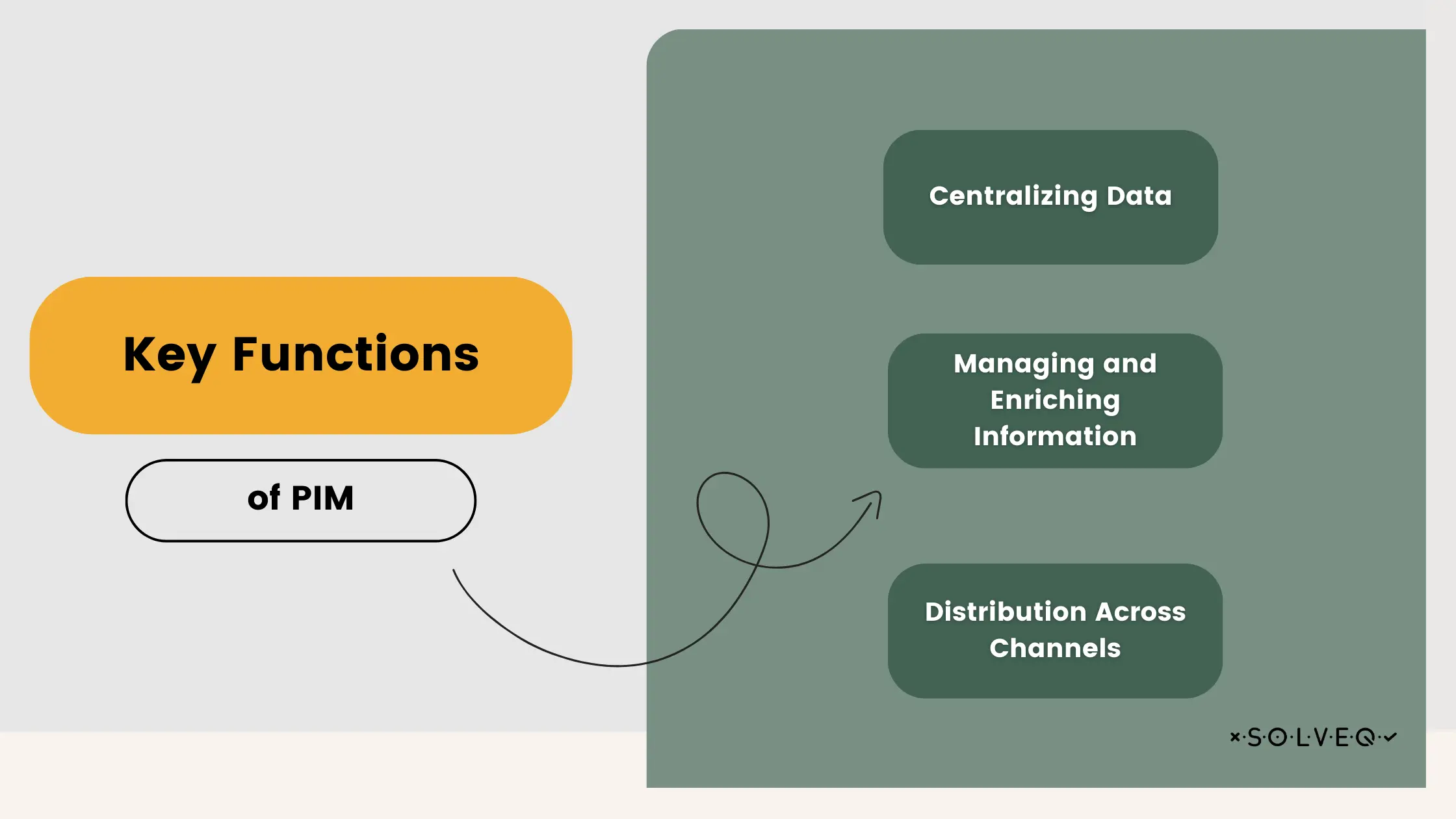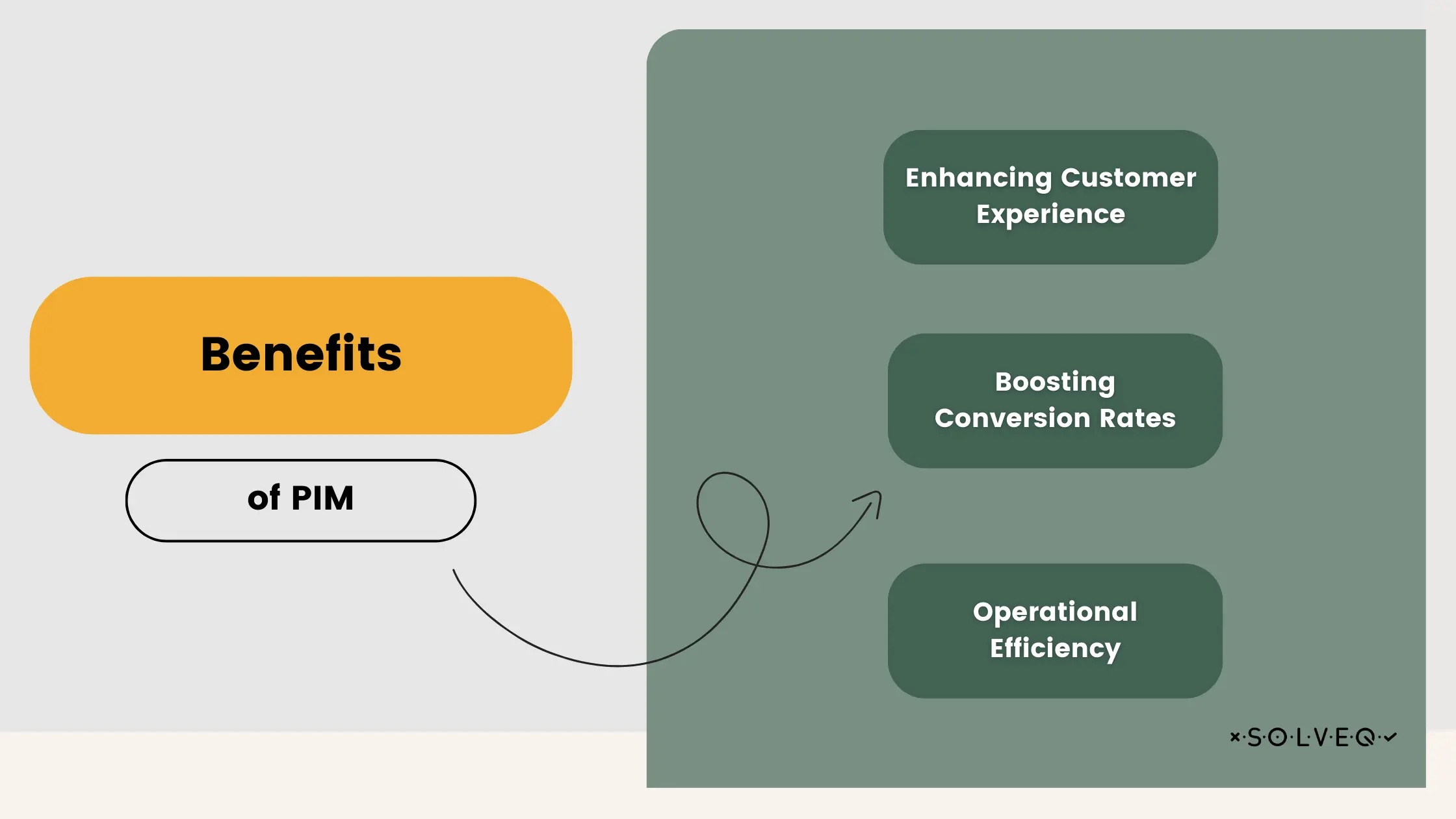Building vs. Buying a PIM System: What's Best for Your E-commerce Business?
2 Apr 2024 • 21 min read

Marcin Kulawik

Navigating the complex world of Product Information Management (PIM) systems can be daunting for any e-commerce business. Whether considering building a custom solution or opting for a ready-made product, the decision carries significant implications for both current operations and future growth. In this comprehensive guide, we delve into the key factors that e-commerce businesses must consider when choosing their PIM solution. From assessing specific business needs and technical requirements to evaluating market options and the total cost of ownership, our aim is to equip you with the insights needed to make an informed decision. Understanding the nuances of PIM systems is crucial in optimizing product information management, enhancing customer experiences, and driving business success.
Introduction to PIM
In the fast-paced and ever-evolving world of e-commerce, the concept of Product Information Management (PIM) has emerged as a cornerstone for businesses aiming to thrive in the digital marketplace. But what exactly is PIM, and why does it hold such significance in the realm of online retail?
Essentially, PIM is a system or software that serves as the nerve center for all product information. It has several key functions:

- Centralizing Data: PIM acts as a repository where all product details are stored. This includes descriptions, specifications, pricing, and imagery.
- Managing and Enriching Information: Beyond just storing data, PIM allows businesses to manage and enrich this information, ensuring that it is comprehensive, accurate, and appealing to potential customers.
- Distribution Across Channels: It distributes this enriched data to various sales and e-commerce platforms, making sure that the information is consistent no matter where it is viewed.
The importance of PIM in e-commerce cannot be understated. The right product information is crucial for providing an outstanding customer experience. Customers depend on accurate and detailed product data to make informed purchasing decisions. The implications of this are vast:

- Enhancing Customer Experience: Accurate and consistent product information helps in building trust with the customers, leading to a better shopping experience.
- Boosting Conversion Rates: When customers find reliable and detailed product descriptions, they are more likely to proceed with their purchase.
- Operational Efficiency: With a well-managed PIM, businesses can streamline their processes, reducing errors and saving time and resources.
The quality of product information directly influences a customer’s decision-making process, impacting the business’s bottom line. As businesses scale and extend their digital footprint, they often encounter a crucial crossroad: the decision to either build a custom PIM solution that caters specifically to their unique requirements or to invest in a ready-made, off-the-shelf PIM product. This decision is critical, as it affects not just the immediate operational needs but also the long-term scalability and success in the competitive digital marketplace.
Why Care About PIM in E-commerce?
In the realm of e-commerce, the significance of Product Information Management (PIM) systems extends far beyond simple data organization. PIM's role is integral in shaping various aspects of an online business, from customer interaction to operational efficiency. Understanding the multifaceted benefits of PIM systems can provide valuable insights into their necessity for e-commerce businesses.
Data Consistency: A Cornerstone for Brand Trust
- Uniform Brand Experience: PIM ensures that product information is consistent across all customer touchpoints. This uniformity is essential in crafting a cohesive brand experience, reinforcing trust and credibility among customers.
Centralized data management through PIM plays a pivotal role in this context. It acts as a single source of truth, ensuring that any change or update in product data is automatically synchronized across all platforms. This consistency is vital in maintaining the integrity of the brand, reducing confusion, and enhancing customer satisfaction.
Efficiency in Time and Cost Management
- Streamlined Operations: The centralized nature of PIM significantly reduces the time and resources spent in managing product information across various channels.
The efficiency gained by implementing a PIM system translates into both time and cost savings. By eliminating redundant tasks and streamlining data management processes, businesses can allocate resources more effectively. This efficiency not only lowers operational costs but also frees up teams to focus on other strategic areas, enhancing the overall productivity and growth of the business.
Enhanced Customer Experience and Loyalty
- Accurate and Engaging Product Information: Detailed and reliable product information directly impacts the shopping experience and customer decision-making.
PIM systems ensure that customers have access to rich, accurate, and engaging product descriptions. This high level of detail in product information is crucial in today's competitive e-commerce landscape. It aids customers in making informed decisions, thereby improving the likelihood of purchase and fostering customer loyalty. Enhanced product information quality directly correlates with better customer experiences and higher conversion rates.
Scalability: The Key to Growth
- Adaptability and Expansion: PIM provides a scalable solution that supports business growth and expansion into new markets.
As e-commerce businesses expand their product range and venture into new markets, the complexity in managing product information grows. PIM systems offer a scalable infrastructure that makes managing an increasing volume of product data feasible without a corresponding increase in complexity. This scalability is vital for businesses aiming to grow, ensuring that they can handle the burgeoning product information needs efficiently and effectively.
In essence, PIM systems are much more than just tools for organizing product data. They are strategic assets that underpin key areas of e-commerce business operations. By ensuring data consistency, enhancing operational efficiency, improving customer experiences, and facilitating scalability, PIM systems play a crucial role in the success and sustainability of e-commerce ventures.
How to Build a Custom PIM Solution
Embarking on the journey to build a custom Product Information Management (PIM) solution can be a challenging yet rewarding venture for e-commerce businesses. It allows for the creation of a system tailored to the unique requirements of the business. Here’s how one can approach building a custom PIM solution:

Understanding Business Specifics
The first step in building a custom PIM solution is to thoroughly assess your business's specific needs. This involves understanding the types of products you sell, the channels through which they are sold, and the internal processes involved. Factors such as the volume of product data, diversity in product types, and complexity of sales channels should be taken into account. This assessment forms the foundation upon which the custom PIM is built, ensuring it's perfectly aligned with business operations and objectives.
Selecting Technologies
The selection of the right technology stack is critical. The chosen technology should be able to handle your company’s specific data requirements and scale as the business grows. This might include deciding between cloud-based solutions versus on-premise servers, relational databases, and the programming languages that will be used. The goal is to create a robust, flexible, and scalable architecture that can evolve with your business needs.
Creating a Unified Data Model
Standardizing product information is a vital aspect of PIM. This involves creating a standardized data model that defines how product information is organized, categorized, and formatted. A well-defined data model ensures consistency in how product information is presented across different channels, enhancing data quality and reliability.
User Interface (UI) Considerations
The user interface of your PIM solution plays a crucial role in its effectiveness. It’s important to design a UI that is intuitive and user-friendly, facilitating easy data input, management, and retrieval. A well-designed UI not only improves the efficiency of data management but also reduces the learning curve for users, resulting in better adoption and usage of the system.
Harmonizing with Existing Systems
A key aspect of a custom PIM solution is its ability to integrate seamlessly with existing e-commerce platforms, ERP systems, and other business tools. This integration capability is crucial for ensuring that data flows smoothly across systems, enabling real-time updates and reducing data silos.
Upholding Data Standards
Last but not least, ensuring that your PIM solution adheres to data protection regulations and industry standards is essential. This includes implementing robust security measures to protect sensitive product information and ensuring compliance with standards such as GDPR or CCPA, depending on your geographic location and customer base.
Building a custom PIM solution requires a strategic approach, balancing technical capabilities with user-centric design and compliance standards. By carefully considering these aspects, businesses can develop a PIM system that not only meets their current needs but is also poised to adapt and evolve with their future growth.
Top 5 PIM Tools for E-commerce
In the diverse and competitive world of e-commerce, choosing the right Product Information Management (PIM) tool can significantly impact the efficiency and success of a business. PIM tools vary widely in terms of features, scalability, and cost, making it important to select a solution that aligns well with a company's size, needs, and budget. Here are some top PIM tools, categorized to cater to different business scales and preferences:
For Large Enterprises
- Informatica PIM: This tool is highly favored by large enterprises due to its robust scalability and extensive integration capabilities. It is designed to manage massive volumes of data and complex product information, making it a go-to solution for businesses with extensive product lines and global market reach.
- SAP Hybris: Another top contender for large-scale businesses, SAP Hybris stands out for its comprehensive features that include not only PIM but also e-commerce and marketing solutions. Its ability to integrate seamlessly with a variety of systems makes it a powerful tool for enterprises seeking an all-in-one solution.
For Small to Medium Businesses (SMBs)
- Pimcore: Ideal for SMBs, Pimcore offers a great deal of flexibility and is known for its user-friendly interface. It’s an open-source PIM solution, which means it provides a cost-effective option for businesses with limited budgets. Despite its affordability, Pimcore does not compromise on functionality, offering robust capabilities that cater well to the needs of smaller businesses.
- Akeneo: This is another open-source PIM tool that is highly recommended for SMBs. Akeneo is celebrated for its ease of use and flexibility. It's designed to simplify product information management, making it easier for businesses with smaller teams to maintain accurate and consistent product data.
Cloud-Based Solutions
- Salsify: As a cloud-based solution, Salsify is notable for its strong digital asset management features alongside its PIM capabilities. It offers the advantages of cloud computing, such as scalability, remote accessibility, and lower upfront costs. Salsify's comprehensive features make it an excellent choice for businesses looking for a versatile, cloud-based PIM tool.

These tools represent a range of PIM solutions suitable for various business sizes and needs. Whether a business is a large enterprise requiring a powerful, integrative system, or a small to medium-sized enterprise in need of a more accessible and budget-friendly option, there is a PIM tool available to meet those specific requirements. Cloud-based solutions like Salsify add another dimension of flexibility and scalability, catering to businesses that prioritize remote accessibility and innovative digital asset management. Choosing the right PIM tool is a strategic decision that can streamline operations, improve product data quality, and ultimately contribute to the success of an e-commerce business.
Custom vs Ready- made: Key Considerations for Decision Making
When it comes to deciding between a custom and a ready-made Product Information Management (PIM) system, there are several critical factors that businesses need to consider. This decision can significantly impact the efficiency, scalability, and long-term growth of the company. Here's a closer look at the key considerations:
Business Size and Complexity
The size of your business and the complexity of its operations play a crucial role in this decision. Large enterprises with complex product lines and global market presence may find that custom PIM solutions better cater to their intricate needs. On the other hand, smaller businesses or those with less complex operations might find that ready-made PIM systems provide all the necessary features without the added complexity and cost of a custom solution.
Budget and Resources
Budgetary constraints are a major deciding factor. Custom PIM solutions can be significantly more expensive, not only in terms of initial development but also for ongoing maintenance and updates. Conversely, ready-made PIM systems often have a lower upfront cost and predictable ongoing expenses. It's important to assess the internal resources available for either building or maintaining a PIM system and balance this against the budgetary limitations.
Future Growth
Anticipating future growth is essential. If a business expects rapid expansion, it's important to choose a PIM solution that can grow and adapt with the company. A custom solution can be built with scalability in mind, but it may require substantial ongoing investment. Ready-made solutions, especially cloud-based ones, often offer scalability, but it's crucial to ensure they can handle the anticipated increase in data and complexity.
Technical Expertise
The level of technical expertise required for both building and managing a PIM system is an important consideration. Custom solutions require a high level of technical skill not only to develop but also to maintain and update. This may necessitate hiring specialized staff or outsourcing, which can be costly. Ready-made solutions, on the other hand, generally come with vendor support and are designed to be more user-friendly, requiring less technical expertise for day-to-day operation.
In summary, when deciding between a custom and a ready-made PIM system, businesses must carefully evaluate their size and complexity, budgetary constraints and resources, anticipated growth, and the level of technical expertise available. This decision should align with the company’s current needs and future aspirations, ensuring that the chosen PIM system can effectively support the business as it evolves and grows.

Steps to Making Your Decision
When faced with the critical decision of choosing between a custom and a ready-made Product Information Management (PIM) system, a structured approach can help in making an informed choice that aligns with your business goals and capabilities. Here are the steps you can follow to guide your decision-making process:
Conduct a Needs Analysis
Begin by thoroughly assessing your business needs, technical requirements, and future goals. Evaluate the types of products you handle, the complexity of your product information, your sales channels, and your customer engagement strategies. Consider how these elements might evolve in the future. This step is crucial in determining whether a custom or off-the-shelf PIM solution is more suitable for your business.
Evaluate the Market
Take a comprehensive look at both custom development agencies and commercial PIM solutions available in the market. Compare the features, scalability, and flexibility of different PIM systems. Research and understand the strengths and limitations of each option in relation to your specific business needs. This evaluation should give you a clearer picture of what is available and what each option can offer.
Consider the Total Cost of Ownership (TCO)
While the initial investment is a significant factor, it's essential to consider the total cost of ownership over time. This includes development costs for custom solutions, as well as ongoing maintenance, upgrades, and support costs. For ready-made solutions, evaluate subscription fees, customization costs, and additional charges for updates or added functionalities. Estimating the TCO will give you a more realistic understanding of the financial implications of your decision.
Leverage Industry Insights
Seek advice from industry experts and peers who have faced similar decisions. Their experiences can provide valuable insights into the practical aspects of implementing and using different PIM solutions. Attend industry events, join relevant forums, or network with other e-commerce professionals to gather first-hand information about the pros and cons of various PIM systems.
Following these steps will help you make a well-rounded and informed decision. By understanding your business needs, evaluating the market options, considering the long-term financial implications, and seeking insights from those with experience, you can select a PIM solution that not only meets your current requirements but also supports your business’s growth and adaptation in the dynamic e-commerce landscape.

Summary
In conclusion, the choice between a custom and a ready-made Product Information Management (PIM) system is pivotal for e-commerce businesses. It requires a careful evaluation of business size and complexity, budgetary constraints, future growth prospects, and available technical expertise. The process involves conducting a detailed needs analysis, exploring the market for suitable solutions, considering the total cost of ownership, and seeking advice from industry experts. This guide has aimed to provide a comprehensive overview of these considerations, helping businesses make an informed decision that aligns with their operational needs and long-term strategic goals. Ultimately, the right PIM solution is key to managing product information efficiently, enhancing customer engagement, and ensuring business scalability.
If you're ready to take the next step in optimizing your e-commerce business with the ideal PIM solution, we encourage you to reach out for a personalized consultation and begin your journey towards streamlined product information management today.
Share:
Looking for expert development team?
Schedule a call with Tech Consultant

Marcin Kulawik
Founder and CEO of SolveQ. Huge fan of building things with purpose, agility, and having fun while changing the World. Loves his family, teammates, and nature.